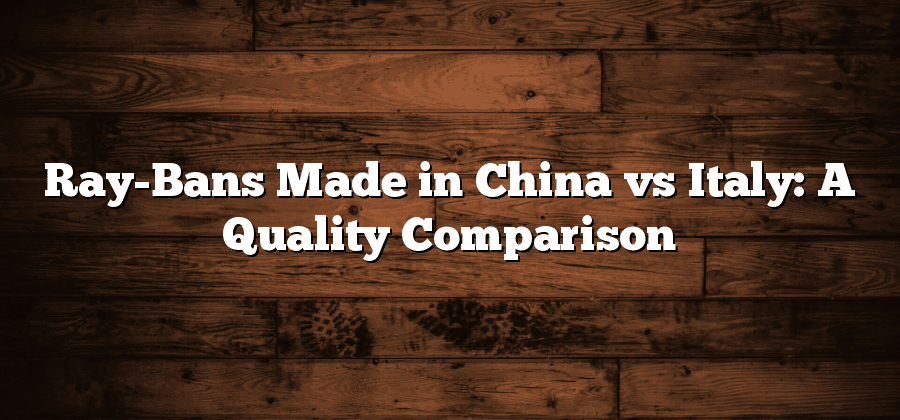The Manufacturing Process of Ray-Bans in China and Italy
The manufacturing process of Ray-Bans in China and Italy showcases the meticulous attention to detail and skilled craftsmanship that goes into creating these iconic sunglasses. Both countries have established an efficient production system that allows for the production of high-quality eyewear on a large scale.
In China, the manufacturing process begins with the selection of high-grade materials, such as acetate or metal, which are carefully sourced to ensure durability and aesthetics. Skilled technicians then cut and mold the materials to form the frames, using precision machinery to ensure uniformity and accuracy. The frames are then hand-finished, with each piece being meticulously polished and buffed to perfection. Finally, the lenses are carefully installed, undergoing rigorous quality checks to ensure optical clarity and UV protection.
Meanwhile, in Italy, the manufacturing process follows a similar pattern but with a distinct focus on craftsmanship and attention to detail. Italian artisans, renowned for their traditional techniques, play a vital role in the creation of Ray-Bans. They meticulously handcraft each frame, focusing on intricate details and design elements. The frames undergo multiple rounds of polishing to achieve a flawless finish, with craftsmen working diligently to ensure that every pair meets the highest standards of quality. The lenses are then carefully fitted, and the sunglasses undergo rigorous testing to guarantee their durability and performance.
• In China, the manufacturing process begins with the selection of high-grade materials.
• Skilled technicians cut and mold the materials to form the frames using precision machinery.
• The frames are hand-finished, meticulously polished, and buffed to perfection.
• Lenses are carefully installed, undergoing rigorous quality checks for optical clarity and UV protection.
In Italy:
• Italian artisans play a vital role in creating Ray-Bans, utilizing traditional techniques.
• Each frame is meticulously handcrafted with a focus on intricate details and design elements.
• Frames undergo multiple rounds of polishing to achieve a flawless finish.
• Craftsmen work diligently to ensure that every pair meets the highest standards of quality.
• Lenses are carefully fitted, and sunglasses undergo rigorous testing for durability and performance.
The Difference in Craftsmanship between Ray-Bans Made in China and Italy
Chinese and Italian Ray-Bans may share the same iconic design, but one can’t help but notice the subtle differences in craftsmanship between the two. When it comes to Chinese-made Ray-Bans, the focus is often on efficiency and mass production. Chinese factories are equipped with state-of-the-art machinery and advanced technology, allowing for high production rates and cost-effective manufacturing processes.
On the other hand, Italian Ray-Bans exude a sense of meticulous artistry and attention to detail. Craftsmen in Italy take pride in their work, utilizing traditional techniques that have been passed down through generations. From hand-cutting frames to delicately polishing lenses, each step in the production process is given utmost care and precision.
While Chinese manufacturing emphasizes speed and volume, Italian craftsmanship focuses on quality and fine craftsmanship. The end result can often be seen in the final products – Chinese-made Ray-Bans may offer affordability and accessibility, but Italian-made ones often exude a sense of luxury and craftsmanship that is hard to match. However, it is important to remember that both variants cater to different consumer needs and preferences, making them equally important players in the Ray-Ban market.
Materials Used: A Comparison between Chinese and Italian Ray-Bans
Paragraph 1:
When it comes to the materials used in the production of Ray-Bans, there are notable differences between those manufactured in China and Italy. Chinese Ray-Bans often utilize a combination of acetate and plastic materials in their frames. Acetate, a lightweight and flexible material, allows for comfortable wear while providing durability. On the other hand, Italian-made Ray-Bans commonly employ higher quality materials such as premium-grade cellulose acetate. This material is known for its strength, stability, and overall superior craftsmanship, which lends itself to a more luxurious feel. The choice of materials in Italian Ray-Bans showcases a commitment to exceptional quality and attention to detail.
Paragraph 2:
In addition to the frame materials, the lenses used in Chinese and Italian Ray-Bans also demonstrate a difference in quality. Chinese Ray-Bans often use polycarbonate lenses, which are lightweight and impact-resistant. While these lenses provide adequate protection, Italian Ray-Bans tend to feature crystal or glass lenses. Crystal lenses are known for their superb optical clarity and resistance to scratches, while glass lenses offer exceptional visual acuity and UV protection. The use of crystal or glass lenses in Italian Ray-Bans reflects a dedication to providing customers with an unparalleled visual experience. These premium lenses contribute to the overall reputation of Italian Ray-Bans as a statement of luxury and style.
Quality Control Measures in Chinese and Italian Ray-Ban Factories
In both Chinese and Italian Ray-Ban factories, stringent quality control measures are implemented to ensure that only the finest eyewear reaches the market. Chinese factories, known for their efficient production processes, have adopted modern technological advancements to meticulously monitor the manufacturing stages. Skilled technicians perform regular inspections at every step, from raw material selection to the final product. Each component is carefully examined for imperfections, ensuring that only the highest quality materials are used.
Similarly, Italian Ray-Ban factories prioritize quality control by adhering to traditional craftsmanship. With a rich heritage in eyewear manufacturing, Italian artisans pride themselves on their meticulous attention to detail. Every pair of sunglasses undergoes a series of rigorous quality tests to meet the discerning standards set by the brand. From ensuring precise lens alignment and tight frame assembly to verifying UV protection, these measures guarantee that each Ray-Ban piece achieves excellence in both aesthetics and functionality.
Comparing the Durability of Ray-Bans Made in China and Italy
The durability of Ray-Ban sunglasses is a crucial factor to consider when purchasing a pair. As iconic as they are, these sunglasses should be able to withstand daily wear and tear, ensuring they remain in good condition for an extended period. When comparing the durability of Ray-Bans made in China and Italy, there are notable distinctions to consider.
Ray-Bans made in China undergo a meticulous manufacturing process that focuses on precision and uniformity. The factories in China utilize advanced machinery and technology to produce sunglasses that meet the brand’s stringent quality standards. However, some critics argue that the emphasis on mass production in Chinese factories may result in less attention to detail and quality control, potentially affecting the overall durability of the sunglasses.
On the other hand, Ray-Bans made in Italy are known for their exceptional craftsmanship and attention to detail. Italian artisans bring decades of expertise to the table, meticulously handcrafting each pair of sunglasses. The factories in Italy prioritize quality over quantity, focusing on producing sunglasses with superior durability. These sunglasses often undergo extensive quality control measures to ensure they meet the highest standards. The combination of skilled craftsmanship and stringent quality control in Italian factories contributes significantly to the enduring nature of Ray-Ban sunglasses made in Italy.



Recent Comments